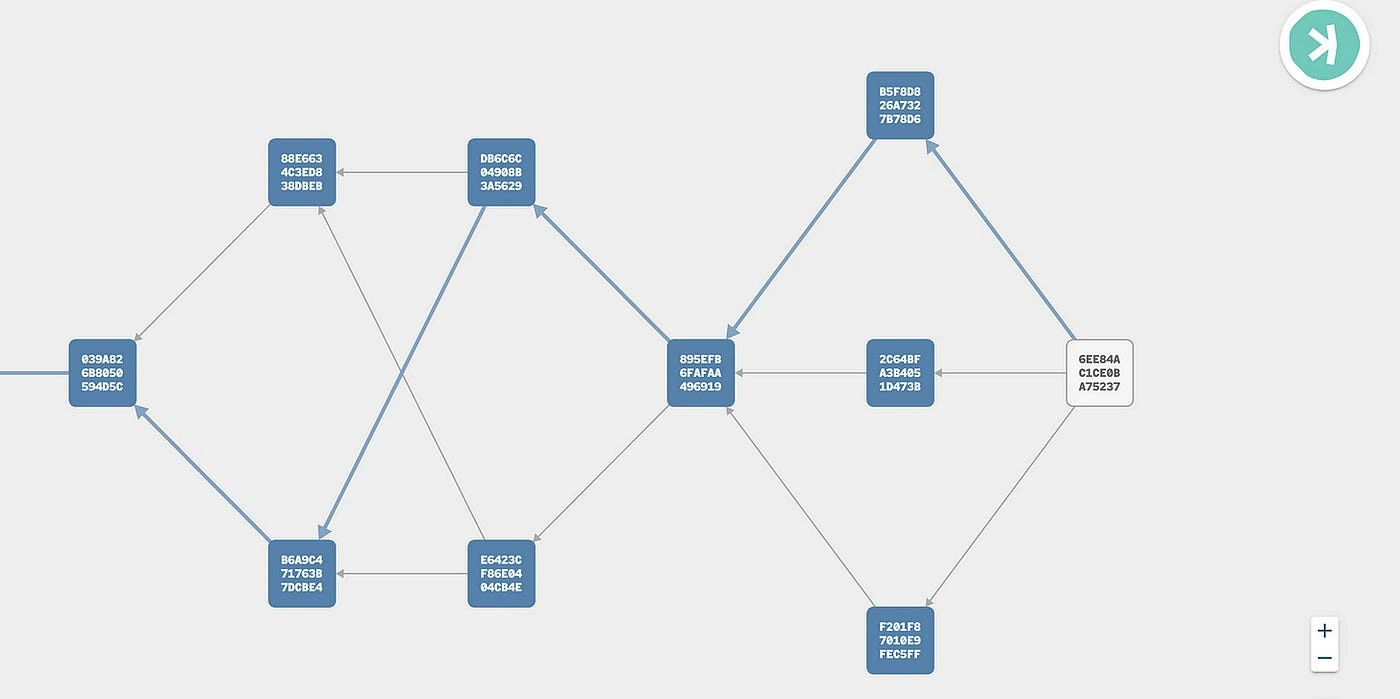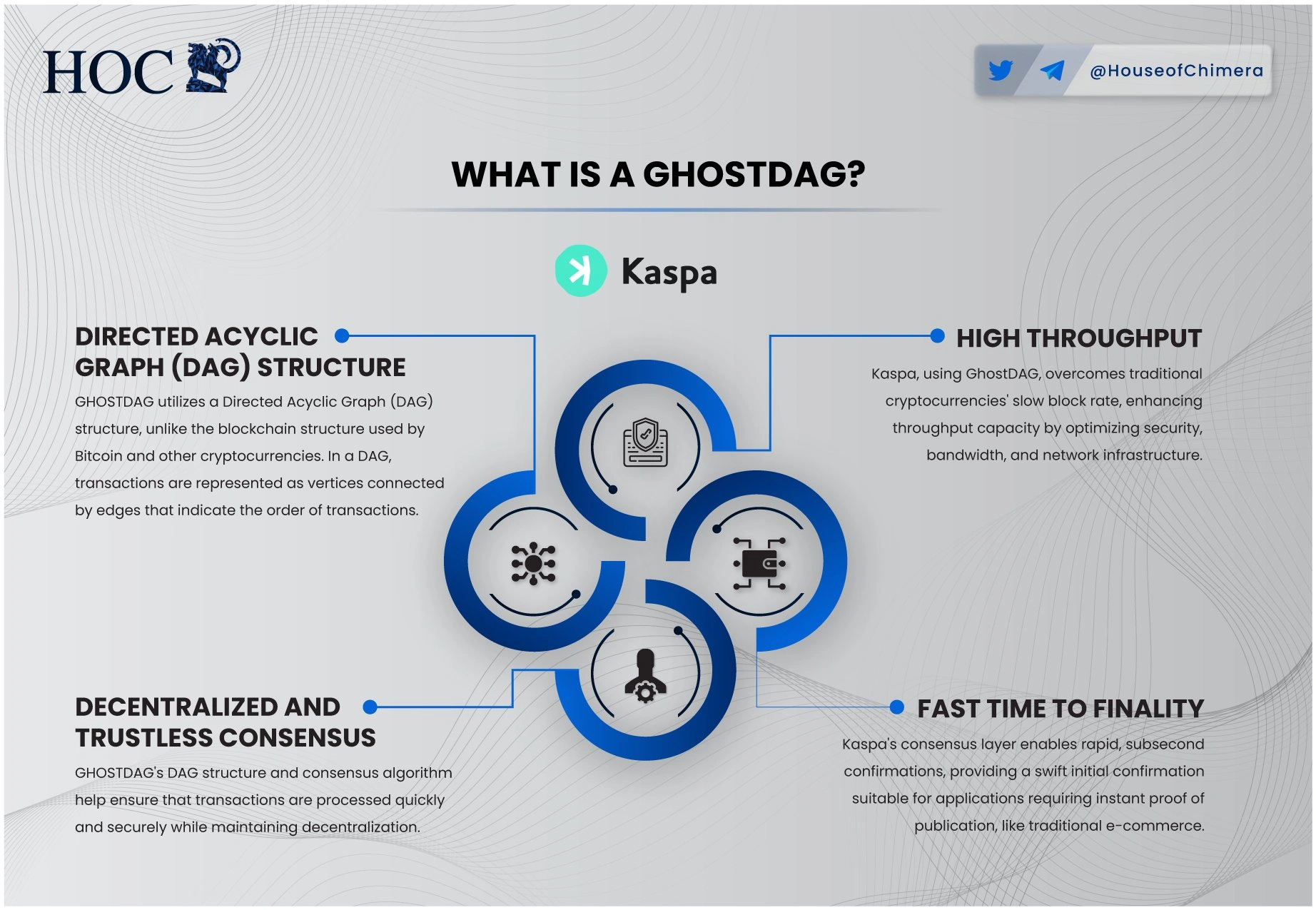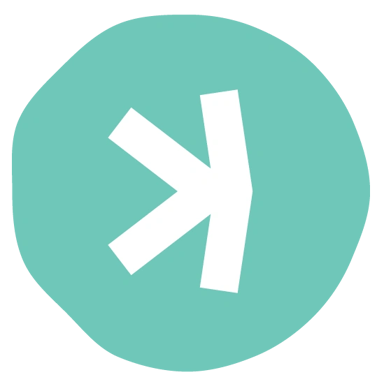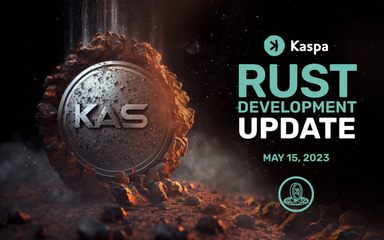Read
Edit
History
Notify
Share
KASPA
Kaspa is a layer 1 blockchain that operates on a proof-of-work system and incorporates the PHANTOM/GHOSTDAG protocol. Using a Directed Acyclic Graph (DAG), the community-run network aims to ensure secure and efficient transactions and foster decentralization and accessibility. [7]
Overview
Kaspa (KAS) is a digital currency network created by Yonatan Sompolinsky, one of the researchers involved in the development of Ethereum's GHOSTDAG protocol. Launched in 2021, Kaspa aims to address scalability challenges faced by traditional blockchains while prioritizing security, efficiency, and user experience. The project was founded by DAGLabs with support from PolyChain's investment driven by its community, embracing open-source principles and decentralized governance. [5][8]
First and foremost I wanted to thank you all for joining and forming this community, for the interest, excitement, and involvement around the project. Seeing my PhD obsession — POW DAG consensus — realize itself into a live network and a spontaneous community is thrilling yet humbling. Thank you, Todah! - Yonatan Sompolinsky
The protocol aims to provide high speed and scalability, employing a proof-of-work consensus mechanism. It is built upon the GHOSTDAG/PHANTOM protocol, an advanced and scalable version of the consensus utilized by Bitcoin. This design allows Kaspa to attain a level of security equivalent to Bitcoin's, without the need for additional assumptions. [3][4]
Diverging from traditional blockchains that discard parallel blocks, the PHANTOM protocol enables these blocks to coexist by arranging them through consensus. In essence, Kaspa aims to simplify the Bitcoin consensus by adopting a straightforward approach. The project emphasizes decentralization and operates as an open-source initiative, driven by a community-based effort. [7]
Approach and Challenges
Kaspa tackles a significant challenge posed by an inherent flaw in the Bitcoin consensus. This flaw allows an attacker to execute a 51% attack with less than 51% computational power by generating slightly fewer blocks than the honest network. Adjusting block rate or size to enhance network throughput increases the isolation rate and compromises security. [9][10][12]
Unlike many other cryptocurrencies that utilize a single chain, Kaspa employs a Directed Acyclic Graph (DAG) where blocks can point to multiple other blocks. Double spending is prevented through the ordering of blocks, with the DAG forming a chain that includes transactions consistent with previous ones. This ordering mechanism is the foundation of GHOSTDAG. [10][12]
Infrastructure
BlockDAG
Kaspa employs a block-directed Acyclic Graph (blockDAG) as its foundational data structure, departing from the traditional linear arrangement of conventional blockchains. This approach enables transactions and blocks to be represented as interconnected nodes within the blockDAG, interconnected by directed edges. One notable advantage of this architecture is the ability to achieve parallel processing and concurrent confirmation of transactions, resulting in improved transactional throughput and scalability. Unlike traditional blockchains that require fixed intervals for block additions, Kaspa's blockDAG allows for swift confirmation of transactions once they receive sufficient approvals or references from other blocks.
 GhostDAG
GhostDAG

GhostDAG is the consensus mechanism employed by Kaspa, building upon the PHANTOM consensus approach. While PHANTOM is not practical due to its NP-hard problem-solving requirements, GhostDAG utilizes the underlying principles of PHANTOM to develop a more efficient and secure algorithm. Extensive formal proofs demonstrate that GhostDAG's block ordering becomes exponentially difficult to reverse over time, even with a high block creation rate, assuming the majority of computational power is held by honest nodes. [13]
Similar to PHANTOM, GhostDAG selects a k-cluster, coloring blocks as Blues (within the selected cluster) and Reds (outside the cluster). However, instead of seeking the largest k-cluster, GhostDAG employs a greedy algorithm to identify a k-cluster. This algorithm constructs the Blue set of the blockDAG by inheriting the Blue set of the best tip, Bmax, and adding blocks outside Bmax's past while maintaining the k-cluster property. [13]

Open-source Framework
Kaspa implements an open-source framework with the aim of fostering transparency, collaboration, and community-driven development. By adopting an open-source approach, Kaspa strives to ensure the integrity and security of the system through public scrutiny of its source code. The goal is to promote trust and confidence among stakeholders by allowing them to access and examine the underlying technology.[11][12]
Furthermore, Kaspa seeks to leverage the power of collaboration and knowledge sharing within its open-source community. By encouraging developers from around the world to contribute to the project, Kaspa aims to foster innovation and drive the evolution of decentralized technologies. The open nature of the platform enables developers to explore and experiment with the codebase, facilitating the creation of diverse decentralized applications (DApps) and solutions.[11][12]
Tokens
KAS
The KAS token serves as the native cryptocurrency of the Kaspa network, playing a role as the primary medium of exchange. KAS tokens are used for transactions and payments within the network, as well as serving as incentives for miners and validators who contribute their computational power to secure the blockchain through Proof-of-Work (PoW). Moreover, KAS tokens are involved in network governance, enabling token holders to participate in decision-making processes and vote on protocol upgrades and changes. [14]
wKAS
The wrapped KAS token, also known as wKAS, is an Ethereum-based representation of the KAS token. It was created to enable seamless interoperability between the Kaspa and Ethereum networks. wKAS tokens are pegged 1:1 to KAS tokens, meaning that each wKAS token represents an equivalent amount of KAS tokens on the Kaspa network. Through wKAS, Kaspa users gain access to various Dapps and services available on Ethereum while maintaining the ability to redeem their KAS tokens on the Kaspa blockchain. [15]
History
Kaspa Crash
Shortly after its launch, on November 24, 2021, the Kaspa network experienced a crash that caused disruptions and raised concerns within the community. The incident lasted for 48 hours and prompted discussions and adjustments to improve the project's development and resilience. [6]
During this time, the project's team made modifications such as replacing the random block reward with a deterministic block reward of 500 Kaspa to enhance operational stability. The community also engaged in discussions regarding an upcoming rebase, ensuring ownership percentages remained unchanged. [6]
The crash led to discussions on implementing a deflationary monetary policy hard fork, with details expected to be specified once syncing and mining activities resumed. Throughout the incident, the Kaspa community demonstrated solidarity and seriousness in addressing the situation, maintaining a positive atmosphere, and supporting one another. [6]
The RUST update
In May 2023, Kaspa implemented a significant update by migrating its codebase from Golang to Rust, a modern and efficient programming language. This transition brings improved reliability, enhanced security, and increased performance to the Kaspa decentralized ledger system. The use of Rust's memory safety mechanisms reduces potential bugs and vulnerabilities, while its concurrency capabilities optimize resource utilization for improved transactional throughput and scalability. The Rust update establishes a streamlined and optimized codebase, facilitating easier maintenance and future development, positioning Kaspa for continued growth and innovation in the decentralized ledger landscape. [2]

KASPA
Feedback
Did you find this article interesting?
Twitter Timeline
Loading
Media







REFERENCES
[1]
[2]
[3]
[4]
[5]
[6]
[7]
[8]
[9]
[10]
[11]
[12]
[13]
[14]
[15]